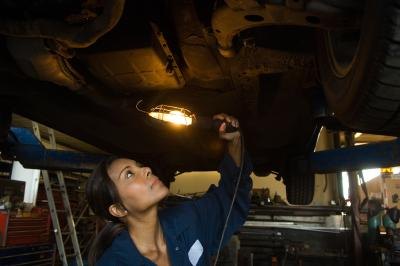The Ford Probe was a sport coupe manufactured from 1989 to 1997, with the second generation of this series beginning in 1993. The GT trim level was a sportier version of the base model, and included a six-cylinder 2.5-liter engine with a double overhead camshaft. This type of engine requires a timing belt to synchronize the movement of the camshafts and crankshafts. The timing belt in a 1993 Ford Probe requires replacement approximately every 60,000 miles.
1 Remove the cable from the negative battery terminal with a socket wrench. Support the engine with a floor jack and remove the mounting bolts on the right engine mount. Disconnect the engine mount and detach the covers for the timing belt.
2 Turn the crankshaft clockwise to align the timing marks. The timing mark on the crankshaft sprocket must align with the timing mark on the oil pump. The timing marks on the camshaft sprockets must align with the timing marks on the cylinder head.
3 Hold the timing belt tensioner in place to avoid stripping the threads on the mounting bolts when you remove them. Disconnect the lower mounting bolt on the timing belt tensioner with a socket wrench first, then disconnect the upper mounting bolt. Remove the mounting bolts on the number 1 idler pulley and remove the pulley. Detach the timing belt from its pulleys.
4 Insert a tool handle of appropriate size into one of the camshaft sprocket holes to hold it in place. Disconnect the mounting bolt for the camshaft sprocket with a socket wrench, and remove the sprocket from the camshaft.
5 Shift your transmission into fourth gear and set the parking brake if your vehicle has manual transmission. Disconnect the dust cover for the flywheel with a socket wrench, and install a locking tool onto the flywheel if your vehicle has automatic transmission. Disconnect the mounting bolt for the crankshaft sprocket and remove the sprocket.
6 Align the dowel on the right camshaft with the slot on the right camshaft sprocket Installed the sprocket onto the camshaft and hold the sprocket in place. Fasten the mounting bolt for the camshaft sprocket and tighten it to between 35 and 48 foot-pounds with a torque wrench. Repeat this step to install the left camshaft sprocket.
7 Align the key way on the crankshaft with the timing mark on the oil pump and install the crankshaft sprocket onto the crankshaft. Tighten the mounting bolt for the crankshaft sprocket to between 116 and 122 foot-pounds with a torque wrench.
8 Hold the timing belt tensioner in place with a vertical press and push the adjuster rod into its hole to align the hole on the piston with the second hole on the case of the timing belt tensioner. Place a metal pin with a diameter of 0.063 in. into the second hole on the timing belt case to hold the piston in place.
9 Turn the crankshaft clockwise to align the timing marks on the camshaft sprockets, if necessary. Turn the crankshaft counterclockwise to move the sprocket back by one tooth.
10 Install the timing belt onto the crankshaft sprocket, number two idler pulley, left camshaft sprocket, timing belt tensioner pulley and right camshaft sprocket in that order. Apply pressure to the timing belt to hold it in place, and install the number one idler pulley. Tighten the mounting bolt for the pulley to between 28 and 30 foot-pounds with a torque wrench.
11 Install the timing belt tensioner and tighten its mounting bolts to between 14 and 18 foot-pounds with a torque wrench. Remove the pin from the timing belt case. Turn the crankshaft two full turns clockwise to align the timing marks again.
12 Adjust the timing belt tensioner so that the deflection of the timing belt between the crankshaft and timing belt tensioner is 0.24 to 0.31 inches.
13 Connect the covers for the timing belt with a socket wrench, and install the right engine mount. Tighten the nuts for the engine mount to between 55 and 77 foot-pounds with a torque wrench and tighten the through bolt to between 63 in 86 foot-pounds. Lower the floor jacks supporting the engine, and attach the cable to the negative battery terminal with a socket wrench.

























